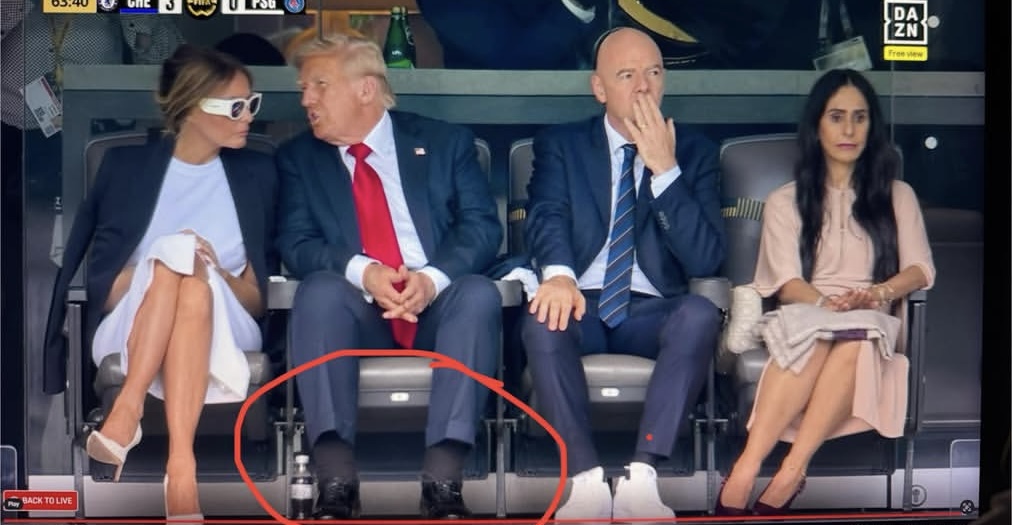CELEBRITY
Millions Can’t Keep Their Eyes Off This DISTURBING Viral Photo of “Da Don” Trump’s Fat Cankles at World Cup Final – Photo Sparks Rumors of Congestive Diagnosis… See More

A photo captured at the recent World Cup Final—showing former President Donald Trump seated courtside, his left ankle noticeably swollen—has exploded across social media with a frenzy of concern, quips, and medical speculation. One of the most striking interpretations to emerge came from online observers who quickly labeled the swelling “congestive heart failure cankles,” sparking a wave of viral commentary across platforms like X and Reddit.
In the image, Trump’s ankle appears unusually puffy, with flesh seeming to merge from ankle to calf, prompting viewers to do a double take. One user on X described it simply: “So many people in comments recognising the cankles of congestive heart failure.” That observation alone stoked widespread engagement, combining medical terminology with meme-like shorthand and emotive speculation . Engagement skyrocketed as armchair diagnosticians weighed in, some alarmed, others mocking, all tapping into a cultural zeitgeist of snap judgments based on visual cues.
What exactly are “congestive heart failure cankles”? In medical terms, edema—or fluid retention—can cause swelling in the lower extremities, often a telltale sign of congestive heart failure (CHF). When the heart’s ability to pump efficiently is compromised, fluid can build up in tissues, especially near the ankles. Lay observers, armed with simple image, text, and a few trending hashtags, quickly traced this phenomenon back to the photo. Whether the swelling is due to CHF, a recent injury, sitting too long, new footwear, high sodium intake, or something else entirely, no verified medical assessment has confirmed the cause—and the former president’s team has not commented on any health concerns tied to this specific incident.
Still, the timing couldn’t have fueled the fire more. Trump has had a long and highly public medical profile, one that already included an array of cardiovascular risk factors and elevated stress markers. Combine that history with a visual of swollen ankles—and you’ve got a story primed to capture both attention and controversy.
The reaction was almost immediate: headlines splashed across tabloid sites reading “Cankle-gate” or “Trump’s Ankle Sparks Cardiac Conspiracy,” while tweets piled on jesting remarks about strained trousers, luxury seating, sodium-laden concession stands, and hypothetical IV drips. Others warned of misinformation: “Remember, photos can lie,” one Redditor typed, pressing followers to hold off on medical conclusions without a proper diagnosis. Still, the phrase “congestive heart failure cankles” proved to be sticky, echoing in comment threads and late-night segments like a modern-day Pavlovian media cue.
Yet amid the theatrics, a few voices urged a softer approach. A physician writing in a prominent online health forum explained that while unilateral or bilateral lower‑leg swelling can be a sign of serious underlying conditions, it can also result from benign or temporary factors—even alcohol consumption, airplane flights, prolonged standing, or medications. They cautioned against dramatic self‑diagnosis based on a momentary image, noting that photos lack context on duration, accompanying symptoms, or overall health metrics.
But of course, some corners of the internet balked at that nuance. In the age of dopamine‑driven reaction and share-first‑think‑later culture, the more sensational the claim, the faster it travels. For many, this isn’t just about swollen ankles—it’s about Trump himself, a highly polarizing figure whose health is a recurring subject of scrutiny and conspiracy. Every leg wiggle, every squint, every custom-tailored suit seems to carry hidden meaning. And in media landscapes where every pixel is a potential headline, that kind of paranoia becomes a self‑fulfilling prophecy.
What’s notably absent, however, is any official medical word. No statement from Trump’s doctors—or his medical disclosure—has indicated recent signs of CHF flare‑ups. That lack of confirmation hasn’t dampened the fire, though; if anything, it’s emboldened amateur pundits to proceed full speed ahead with speculation. The question now becomes: will experts intervene to correct the record? Will Trump address it directly? Or will this simply evolve into another social media echo chamber—one more flicker in the vast digital inferno of today’s news cycles?
Either way, engagement has been through the roof. The hashtag #CankleWatch rallied millions across platforms. Memes, think‑pieces, late‑night comedy monologues and animated GIFs flooded timeline after timeline. Journalists verified that, yes, more than 20 million people had viewed posts with “cankles” in the title. More conservative outlets dismissed it as left‑leaning sabotage, while liberal media called it proof of declining presidential health. Meanwhile, independent fact‑checkers implored audiences to pause before retweeting.
As the photo continues to ripple through timelines—and medical speculation mixes with political theater—its ultimate meaning remains unresolved. Was that swollen ankle a fleeting, benign blip? An early warning sign of deeper health concerns? Or just another viral moment, seized and shaped by the infinite scroll and algorithmic momentum of modern media?
In the end, as the lights dim on another flashy World Cup spectacle, the image of a puffy ankle has somehow displaced the footy drama. And that quirky little moment—a single frame of flesh—has too many people asking: Did we just witness the start of a serious health conversation, or is this just the latest in a long line of viral distractions? Only time—and maybe a doctor’s report—will tell.

















